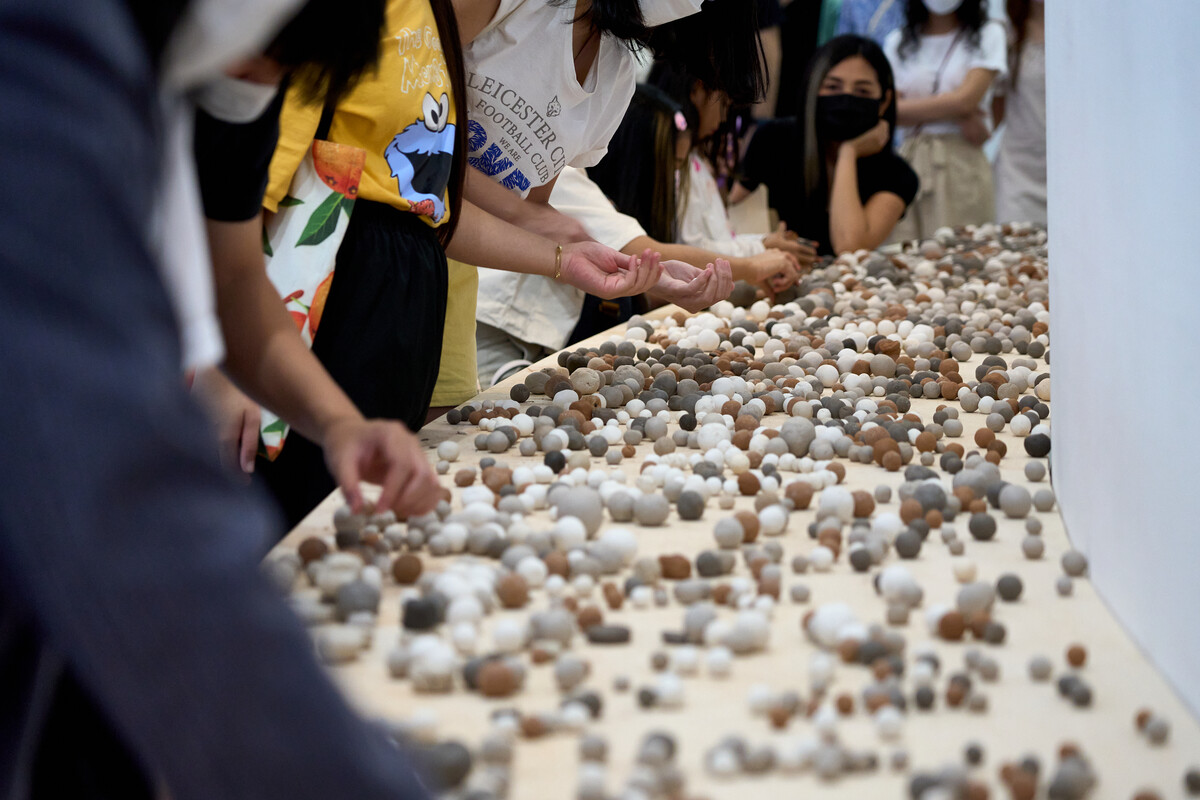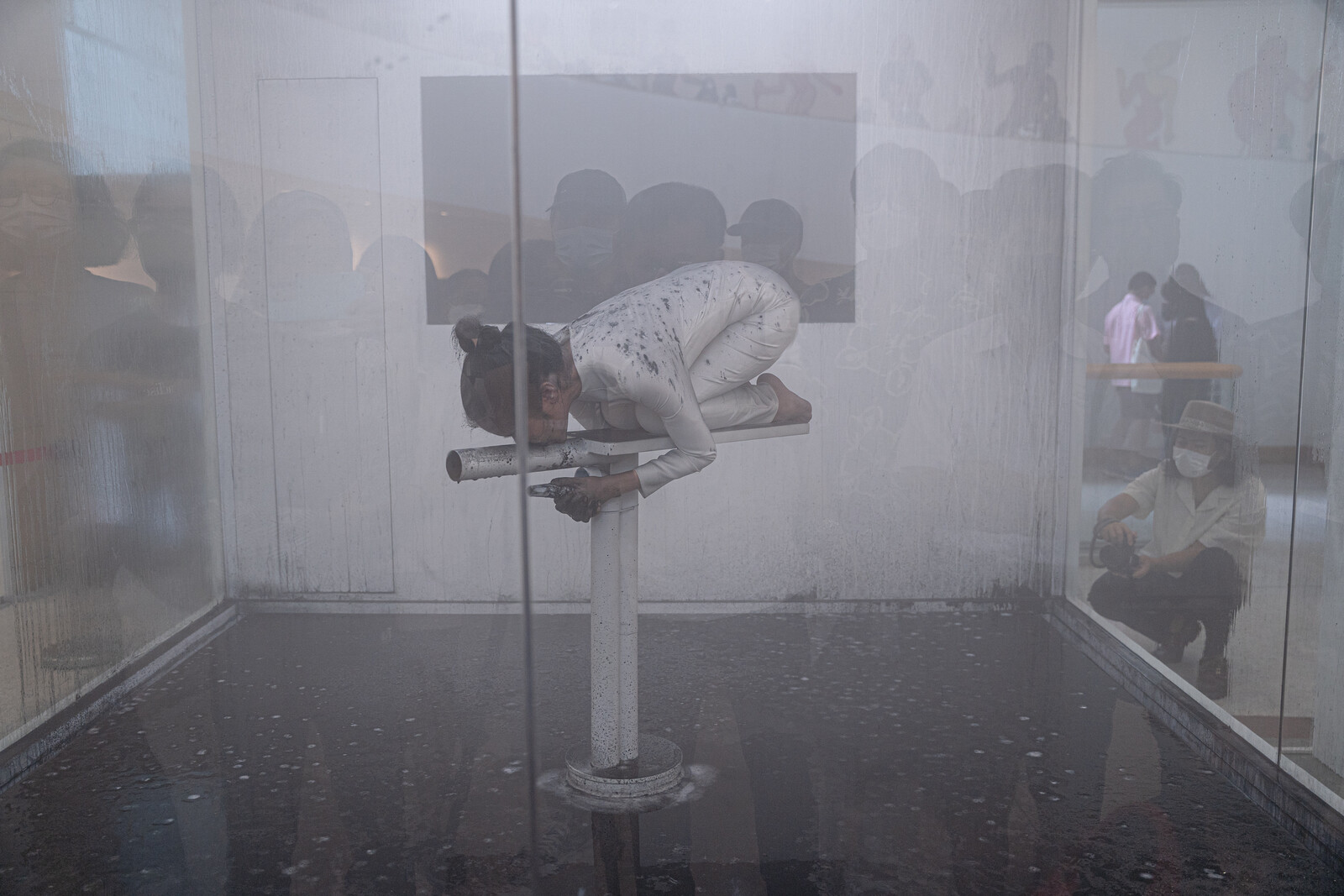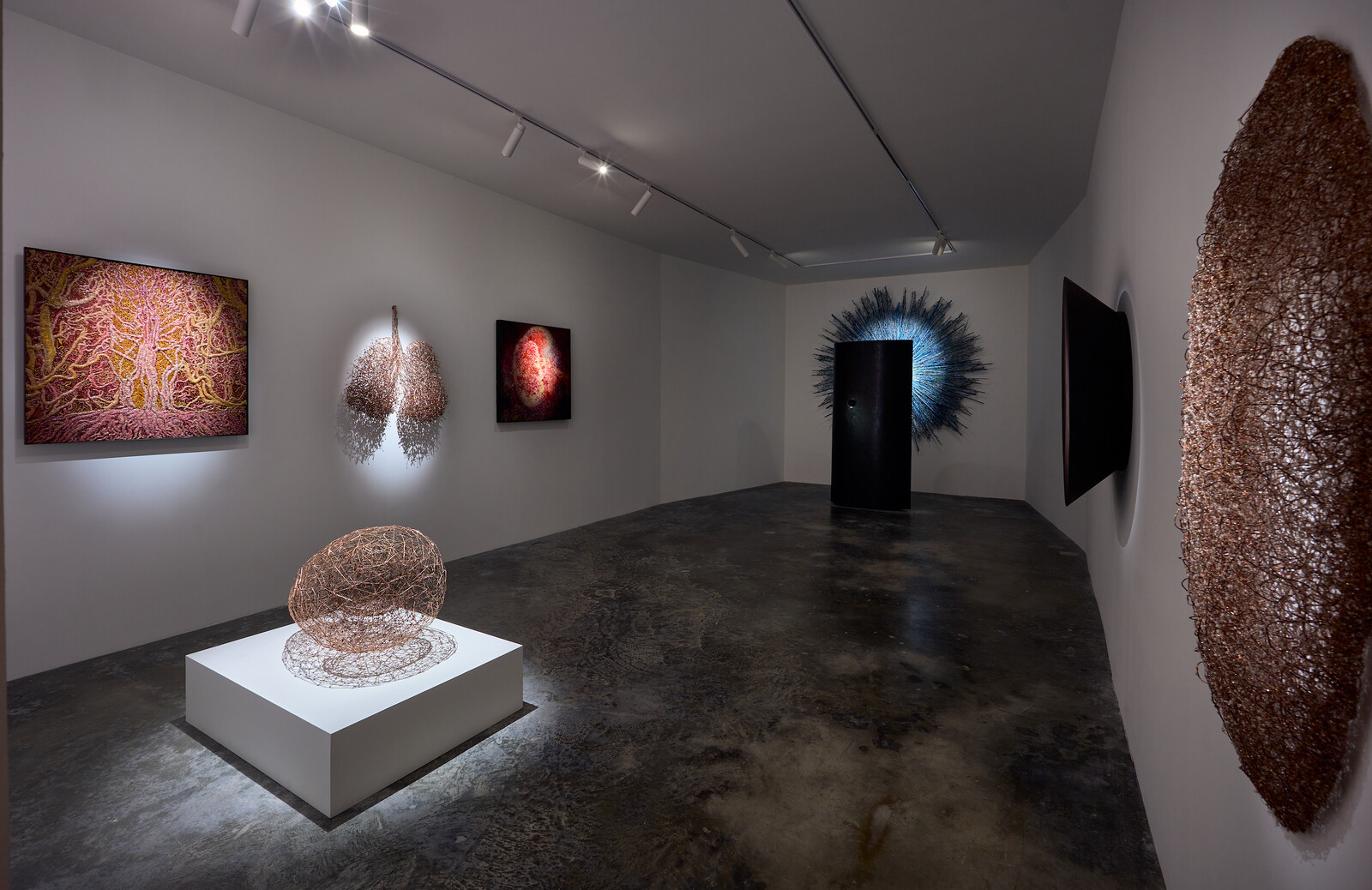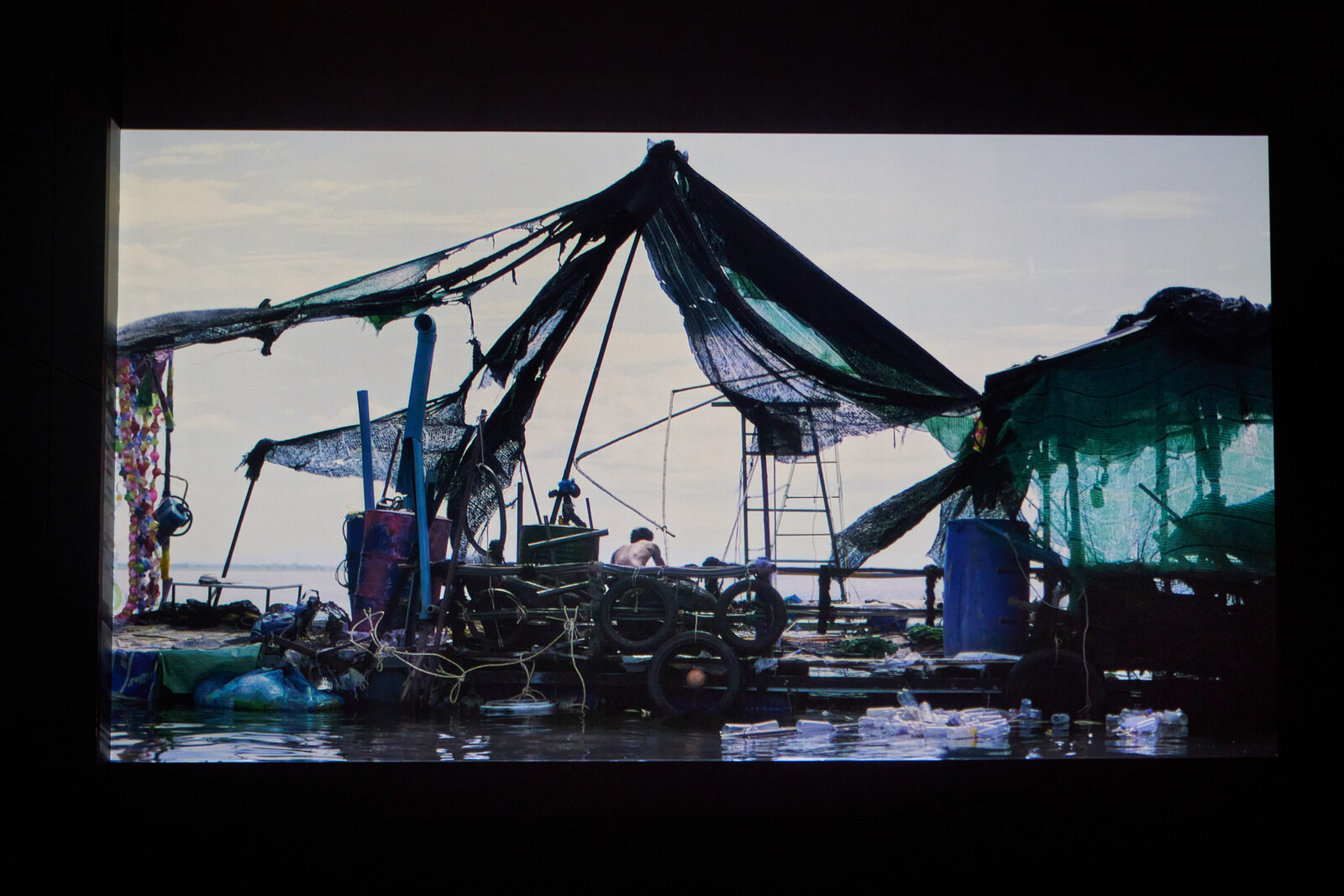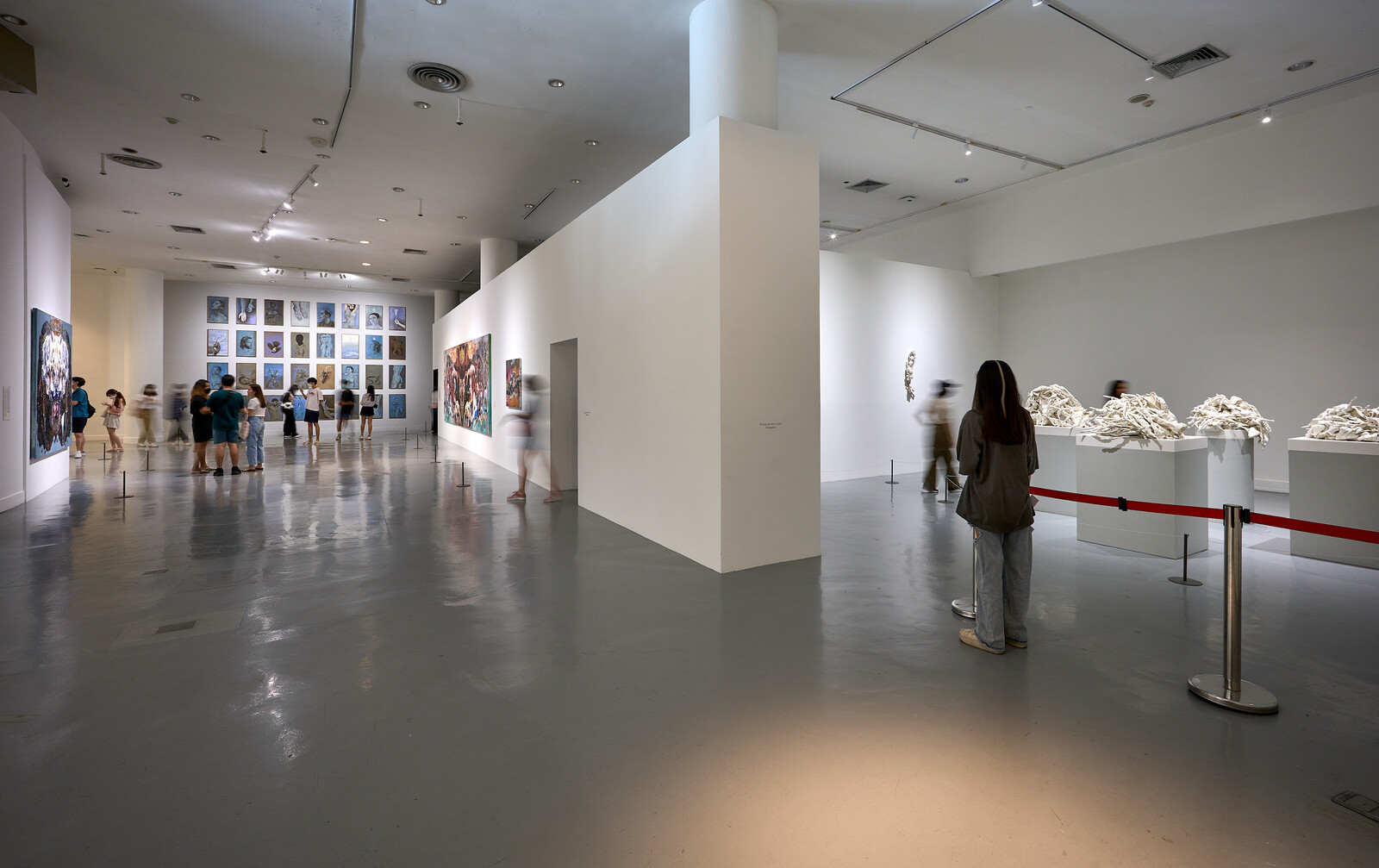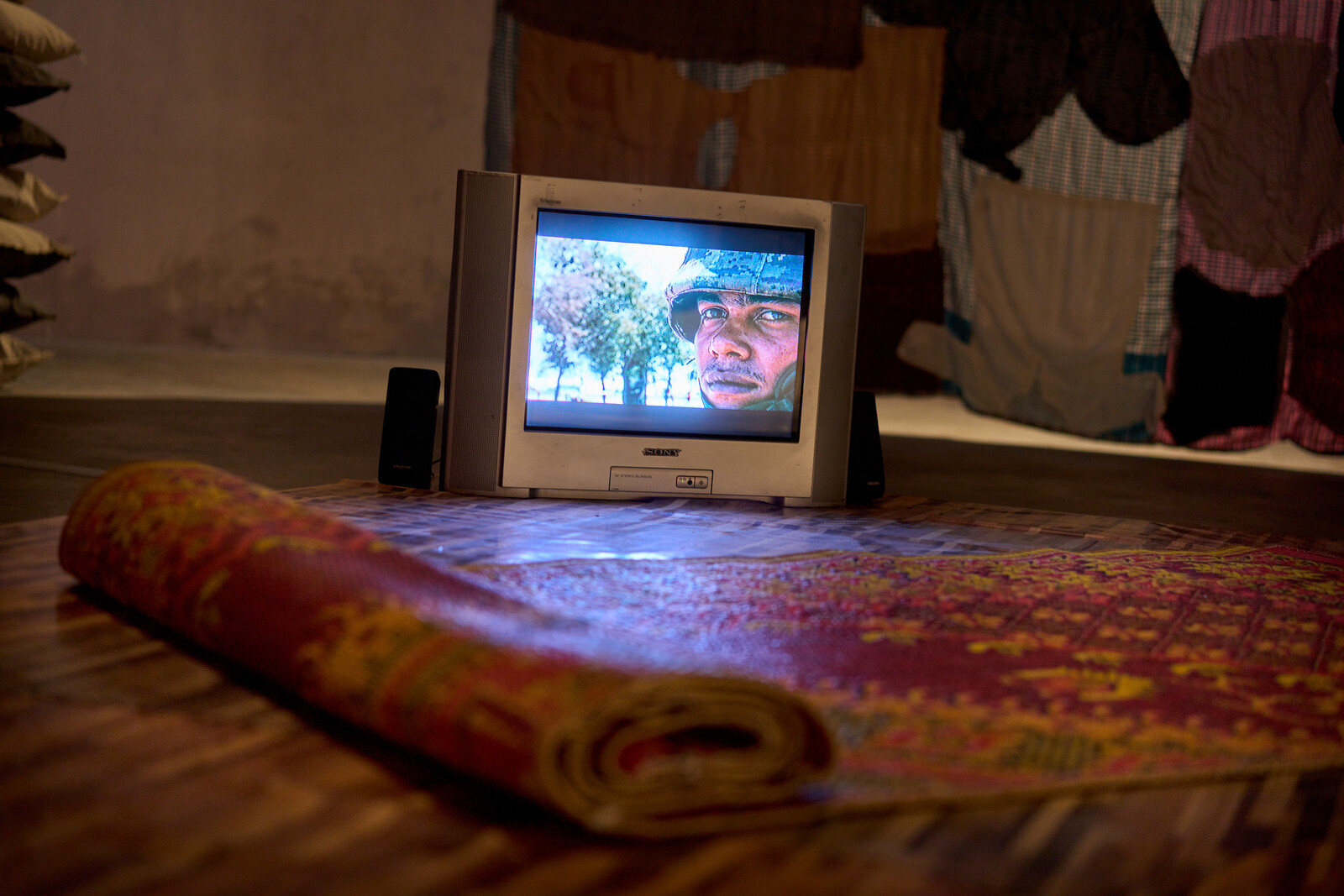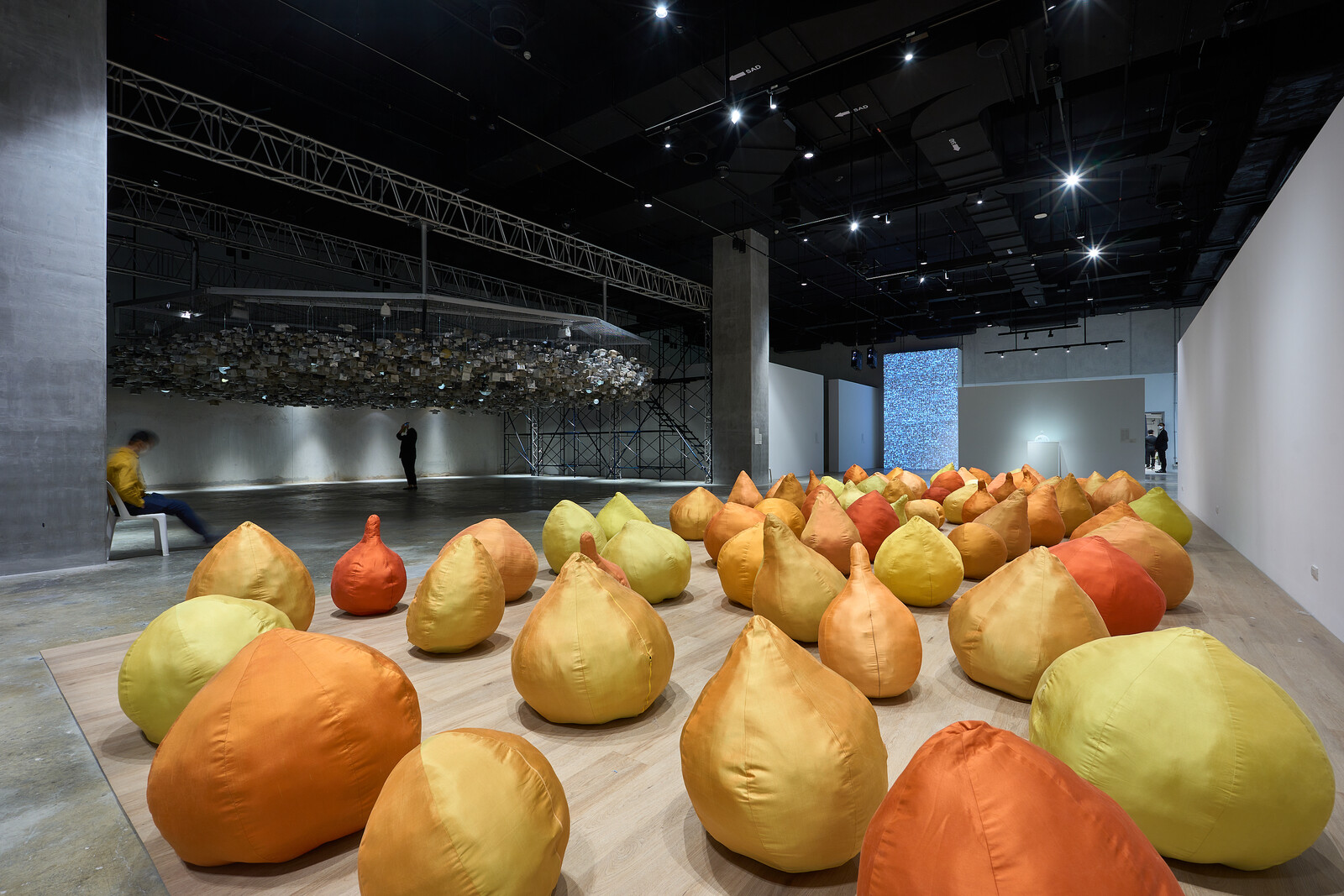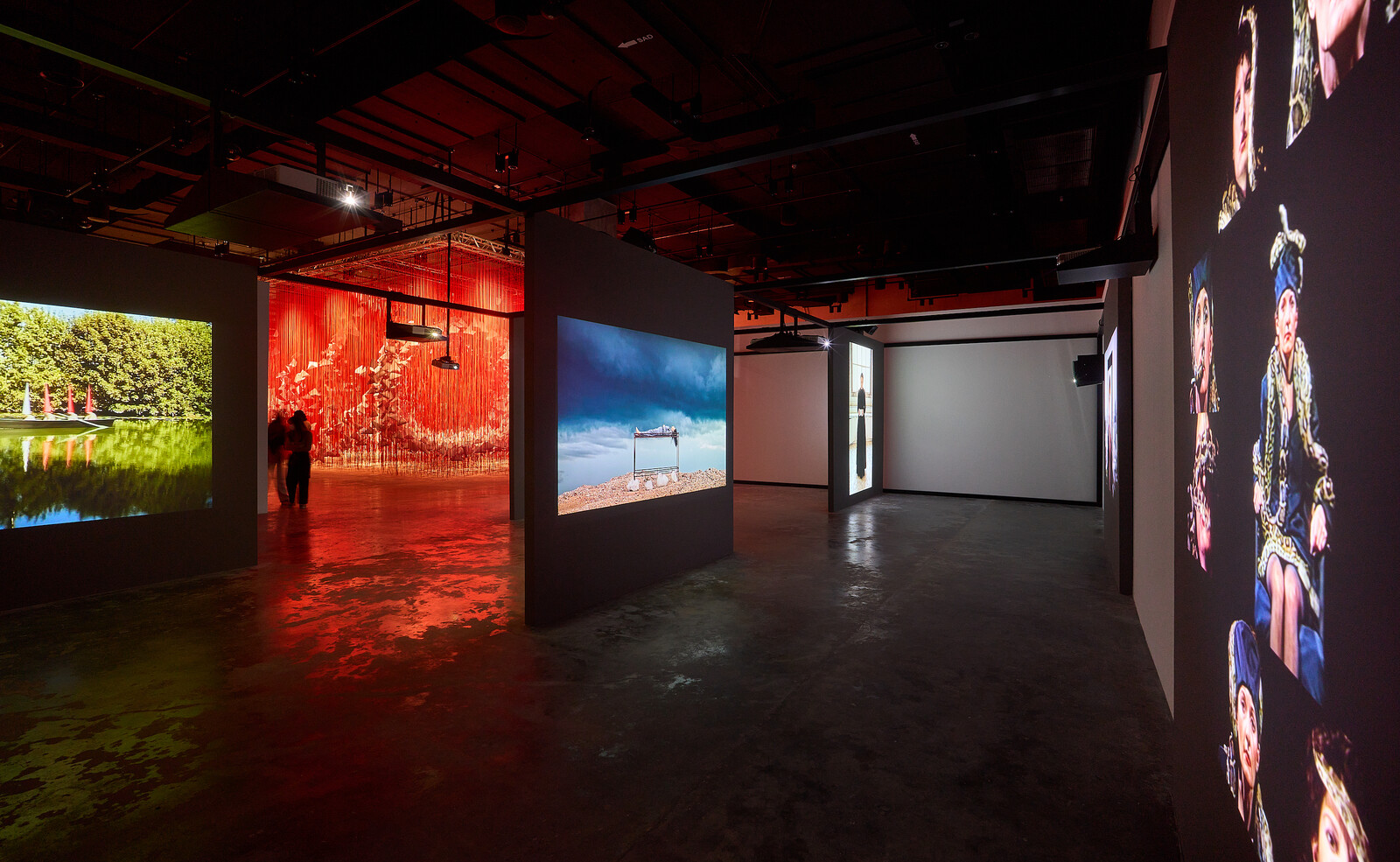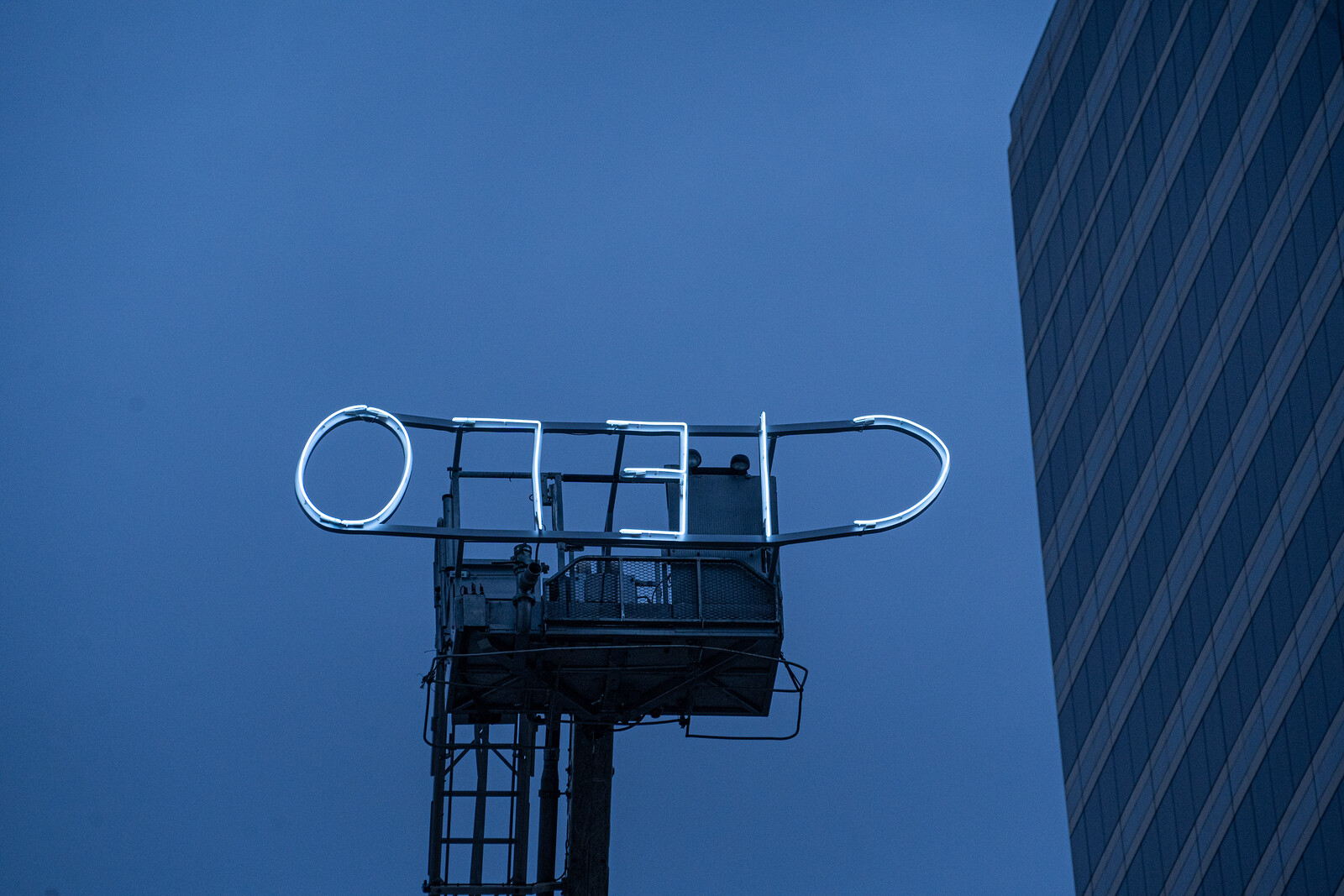The titles for the first two editions of the Bangkok Art Biennale (BAB), “Beyond Bliss” and “Escape Routes,” were catchy rhetorical constructions that signposted a sanguine worldview: art can help us survey, process, and perhaps even surmount the multipolar reckonings of the Anthropocene. Setting a similarly salutary tone for the third edition—the last in a trilogy, according to artistic director Apinan Poshyananda—is “CHAOS : CALM.”
During the opening symposium, Loredana Pazzini-Paracciani (part of a four-strong curatorial team alongside Nigel Hurst, Jirat Ratthawongjirakul, and Chomwan Weeraworawit) remarked that the title’s colon allows for all states in between, rather than enforcing a binary. Her assertion left the tonal spectrum wide open, yet the thematic scope is wider still: BAB 2022 is a heaped potpourri of over 200 au courant artworks ostensibly united around capacious notions of disarray and harmony. Works that evoke dialectics between societal structures or belief systems are piled in alongside those that summon disorderly nature, and others of a more lived and personal bent.
Circling the upper floors of the Bangkok Art & Culture Centre (BACC)—the largest venue—is a heady, often unnerving experience. “Your voice is powerful and it will be heard,” says a pensive AI avatar of Kawita Vatanajyankur, a local video performance artist. “You’ll never be free, and your voice will be silenced,” retorts Kawitash1, a more control-orientated alter-ego that repeatedly contradicts the free-spirited other. Flanking a box for live performances, the two-channel video installation Voice of the Oppressed (2022) articulates a yearning for self liberation in a world of dehumanizing authoritarianism. Channeling the radical spirit of Paulo Freire’s Pedagogy of the Oppressed (1968), its ominous, looping call and response is also among the most legible articulations of the theme’s madly oscillating dualism. In the exhibition rooms, meanwhile, the gravity of such socially engaged work is leavened by contributions of a meditative and self-searching nature, such as Kimsooja’s participatory clay installation (Archive of Mind, 2022) and the life-affirming abstract canvases of the Anangu people, an Australian aboriginal community.
If nothing else, the show fills a void—or begins to. A large subset of the Thai art scene, for whom funding resources are scarce, has grasped the opportunity to contribute to a slick local mega-event, and the resulting commissions are, for the most part, stimulating. At The Prelude, a plush show suite for the forthcoming One Bangkok real estate development (“the Bangkok of tomorrow”), Chitti Kasemkitvatana’s SilentDREAM (2022) recodes localized data, namely King Rama IV’s city modernization plans and the nineteenth-century temple murals of painter-monk Khrua In Khong, as buzzing matrices of image and sound—a metaphor for the dynamism of history. At the BACC, Jakrawal Nilthamrong’s video installation Rhizome (2022) decenters humanity in a world where water simultaneously sustains and threatens life. Reminiscent of The Naked Island (1960), Kaneto Shindo’s dialogue-free study of the struggles of agrarian life, its uncanny depiction of a man, woman, and cow living aboard a rickety raft challenges anthropocentrism. For local audiences, the works by 73 artists from 31 countries also offer a rare steppingstone into the unfamiliar practices of far-flung artists. Russian collective AES+F’s Turandot 2070 (2019 - Ongoing), for example, is an exuberant, #MeToo-inspired video piece about an authoritarian techno-matriarchy ruled by long-limbed aliens who methodically torture men. Seeing a room of teenagers put their phones away to soak it up swept aside my misgivings. Momentarily, at least.
In totality, this exhibition appears uninterested in fleshing out the welter of themes it invokes. The sense of complex ideas only cursorily touched upon is most pronounced at BAB’s hall at the newly rebuilt Queen Sirikit National Convention Centre (the venue for last month’s Asia-Pacific Economic Cooperation meeting). Here old works by big names (Marina Abramović, Jake Chapman) alternate illogically with new surprises, such as Rokayasala (House of Dis-ease) (2022), Be Takerng Pattanopas’s room of delicate mixed-media sculptures and paintings, each a transporting depiction of the interior life of the diseased human body. The venue is a spectacular pile-up of non-sequiturs.
The event appears blind to the raw qualities that make Bangkok—a sprawling architectural palimpsest throbbing with site-specific potential and small histories—such a creative hothouse. More so than previously the “city route,” a suggested tour, seems to have been designed to acclimatize viewers to the main corporate backer ThaiBev’s questionable paradigm of sustainable progress: a sparkling vision of future Bangkok dominated by “holistically integrated” mixed-use districts and other featureless non-places. Most of the works secreted around three city temples, meanwhile, feel less like deep engagements with the spatial and spiritual realms of Theravada Buddhism than photogenic decoys masking an indifference to urban place or placemaking.
Benefiting from tight partnerships and logistical integration with ThaiBev and its affiliates, BAB is the resource-rich populist biennale that Poshyananda—whose CV includes the acclaimed “Contemporary Art in Asia: Traditions/Tensions” (1996) in New York and the first Thai pavilion at the Venice Biennale—could not realize during his frustrating tenure at the Ministry of Culture’s Office of Contemporary Art and Culture (OCAC), which he helped establish but ceased involvement with in 2017. His excoriating recent reviews for the Bangkok Post of the OCAC’s projects are yet more public salvos in an ongoing battle of competency.1 Concurrently, he has cast aside the national frameworks and disturbing Thai events and politics he grappled with for much of his career, and instead adopted the guise of a compassionate universalist specializing in, as he stated recently, “parallel reflections of what is going on in the world.”2
All of which prompts hard questions about BAB’s future. Are the boosterist aims threaded through the trilogy—thrust Thai artists onto a wonky international pedestal, shock and awe audiences with loose themes and star power, be a handmaiden to neoliberal agendas—the only late-career legacies Poshyananda wishes to own? In what direction or directions, now that three more editions have been confirmed, will he head next? Perhaps the most urgent questions of all, though, are stimulated by Vatanajyankur’s earnest exercise in performativity on the BACC’s rotunda: Where does “CHAOS : CALM”—a righteous pan-global romp through everything from Filipino militarism to Gulf Futurism—sit on the sliding scale of emancipation and oppression? When it comes to Thailand’s civilizational angst and collective catharsis, does it veer closer to “your voice is powerful” or “you’ll never be free”?
It bears recalling that in the early days of the 2020 edition, 25 BAB artists responded to the government’s heavy-handed suppression of the youth-led “Ratsadon” protests outside the BACC with an open letter. Artists must “be able to speak directly to the situations that have literally arrived at our doorstep,” they wrote.3 Two years on, the domestic social sphere haphazardly presented across the 11 city-wide venues is a carefully sanitized and poorly contextualized one, concealing a vibrant spectrum of political dissent and critical artistic practices. The inclusion of agit-prop and conceptual installations from Art For Air, a recent anti-air pollution art festival up in Chiang Mai, as well as large-scale tapestries from Satu ≠ Padu Collaborative’s community weaving project in the country’s separatist insurgency-stricken Deep South, implies openness and conviviality—and suggests that societal concerns can be freely voiced in Thailand. But both are arguably smokescreens. Excluded are the antagonistic forms of art activism and collectivism speaking directly (and indirectly) to the situation facing Thailand’s latest quashed pro-democracy movement, from archives of protest paraphernalia to social critiques by publishers, theater troupes, and artists.
This omission is hardly surprising given the family-owned ThaiBev drinks conglomerate’s ties with the state apparatus and a military-proxy government with fervently royalist and dictatorial instincts. Yet the curators’ attitude of urbane perceptivity vis-à-vis discourses of justice is undermined by the glossing over of dismal on-the-ground realities: not least, Thailand’s institutionalized intimidation of prisoners of conscience, most of them young adults awaiting sentencing for breaking the country’s draconian lèse-majesté law. All voices are powerful at BAB 2022, it seems. Unless they might bite the corporate hand that feeds it.
See, for example: Apinan Poshyananda, “Contemporary mediocrities,” Bangkok Post (3 May 2021), https://www.bangkokpost.com/life/arts-and-entertainment/2109495/contemporary-mediocrities; and “Frolicking in Korat,” Bangkok Post (14 March 2022), https://www.bangkokpost.com/life/social-and-lifestyle/2278767/frolicking-in-korat.
Tan Siuli, “A Conversation with Dr Apinan Poshyananda,” ART SG, https://artsg.com/news/a-conversation-with-dr-apinan-poshyananda.
See Sarah Cascone, “Two Dozen International Artists in the Bangkok Art Biennale Have Signed an Open Letter Decrying Crackdowns on Pro-Democracy Protests in Thailand,” Artnet News (22 October, 2022), https://news.artnet.com/art-world/bangkok-protest-1917372.
